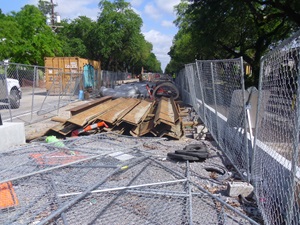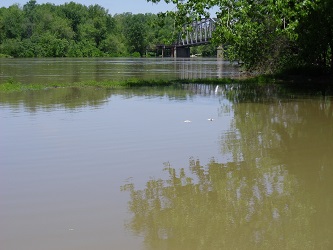Are Impact Fees A
Good Way to Pay for City Expansion?
Published: June 25, 2024
Are you in a rapidly growing area where new development always seems to be outstripping the capacity of your streets, utilities, and other infrastructure? If so, you aren’t alone.
Some cities attempt to meet these future infrastructure needs by charging impact fees. I have been privileged to be a planner in two fast growth situations, one of which imposed impact fees on new development in some parts of its area. My experience was mostly positive, but if you are a planning commissioner or elected official thinking about using this tool, look squarely at the advantages and disadvantages of impact fees.
If you are not familiar with how the term is used in a good community, a local government may charge an impact fee to a developer, or actually to any person or corporation, that wants to construct a building. The fee is collected when the building permit is issued.

Sometimes the public entity charging and collecting the impact fee will share the funds with another public body, as outlined in an intergovernmental agreement. For example, in one county where I served as planning director, my department collected impact fees on behalf of the school district, which was severely impacted by population growth.
Cities and towns in growth mode are nearly always struggling to keep up with the need for more capital improvements expenditures. A capital improvement for a government refers to an investment that has a useful life of multiple years, typically specified in municipal policies or ordinances. Examples are streets, water and sewer lines, and buildings.
Residents in fast-growing areas often become rebellious about any talk of tax increases to cover future infrastructure needs. One advantage of impact fees is that at their best, they function as a kind of user fee so that the people who pay (in this case, through higher home prices or rents) are the same ones who benefit most.
This characteristic alone makes impact fees attractive to some elected officials. However, one purpose of this article is to point out that you can’t just pick a number out of the air and start collecting the fee.
Impact fees will only withstand legal challenges if they are reasonably related to the estimated future cost of adding street lanes, signalizing intersections, building bridges or drainageways, or extending water or sewer lines or even building new water or sewer plants. In a growing community, it is likely that future construction will cause one or more of these systems to need expansion.
In a contracting community, or a declining part of a community, that will not be the case. If your downtown is half deserted, and someone wants to construct a two-story building on a vacant lot, that will not lead to a major street widening project, for example. It is very unlikely that the existing sewer or water pipes would need to be replaced by a larger capacity pipe. This is why impact fees generally are only contemplated and defensible when population and the physical footprint of a community are rapidly expanding.
Someone will argue that impact fees really are only used in the U.S. in the case of hard, quantifiable costs of the kinds that the public works department deals with. That is most often the case, but you definitely can charge impact fees for school construction and conceivably for other public services.
To be just a bit more imaginative, if you are under state or federal mandates for environmental protection of an ecosystem common in your jurisdiction, you might be able to quantify likely costs of protective measures and how much additional population in a certain area would add to that burden. I do not know of an example of this latter application though.
The Impact Fee Probably Should Not Be the Same Everywhere
Now I need to add another layer of complexity in this discussion of the advantages and disadvantages of impact fees. The correct, legally defensible way to impose impact fees in most cities is to calculate them on a district basis. This is where I have seen staff time costs and consultant fees tend to escalate.
Let's say that another bridge over a river or lagoon will be required eventually if a large percentage of new development lands in one part of the city. The first step would be to have traffic or other engineers make a reasonable estimate of how much a residential unit or a thousand square feet of commercial area will contribute to demand for the new bridge.
But second, you then must determine whether you can make a similarly reasonable and defensible argument about the primary geographic area to be served by the infrastructure improvement. Sometimes that will be relatively self-evident. For example, if you need a new bridge to the mainland, island residents and businesses would benefit most. In other cases, you would need some detailed studies to determine where the current users of a public improvement live or work.
I have observed that some cities are a bit sloppy in the way they impose the impact fees. They may have a fairly vague capital improvements plan covering a fixed duration, with a total dollar figure attached to it, and they might come up with a reasoned or guesswork amount of citywide development they project each year. Then they divide the total capital improvement costs by the estimated total number of housing units to be built, and they say this is the impact fee. If the figures and assumptions are as simplistic as I am making it sound, this is a pretty good way not only to land in court, but to lose in court.
Don’t do that.
This is why I argue strongly in favor of setting up impact fee districts or zones, each with their own set of capital improvements that will be needed in the future. Think about the fact that most downtowns already have enough infrastructure, and so it may be inappropriate to charge an impact fee at all in those locations. In other areas of the city, infrastructure capacity may have been increased recently, making those neighborhoods unlikely subjects for an impact fee.
You need cost estimates that are far better than just your city engineer's educated guess. An in-house or consulting engineer needs to calculate those estimated future costs in detail, stating underlying assumptions clearly. Make no mistake. There will always be assumptions, including inflation rate for the type of construction in question, future value of money, the behavior of residents and employees, and future lifestyle preferences. However, those assumptions need to be both reasonable and documented.
Impact Fees Are Not a Substitute for Good Planning
Finally, I want to comment that if the political system will tolerate it, good planning is a better approach to managing growth than impact fees alone. After all, sound land use planning would direct growth to areas where excess capacity in roads and utility lines and plants exists now, not to parts of the city where road and utility capacity are non-existent or stretched thin already. In many situations, there is plenty of infrastructure in parts of a city that have been allowed to deteriorate.
If your city has the guts, solve the social and economic problems of the city center so those wide streets will once again be lively and attractive for redevelopment and infill housing. That’s even better than collecting an impact fee on the basis of predicted growth on the periphery.
Provided you have a bold land use plan, you still may want to add in an impact fee program. Not only would the impact fee help with the pragmatic problem of how the city can afford the new infrastructure, but also the fee will have a deterrent effect on developers who do not really need to be in that location. Yes, to build high-end luxury condos by the beach, a developer may be willing and able to pay a high fee, regardless of the contribution of that development to the need for a new bridge. However, in some cases, the fee will motivate developers to search for alternative locations.
Isn't that what you want if you really believe in city planning?
Summary of the Advantages and Disadvantages of Impact Fees
In sum, the advantages of impact fee programs include:
- They are a way to raise the revenue needed for adding capacity to infrastructure
- They represent an equitable distribution of the cost burden in that the population most likely to benefit from the infrastructure improvement on a daily basis will be the population that pays the impact fee, either directly as a builder or indirectly as a home purchaser or renter.
- They may deter development in areas where infrastructure is strained, providing there are several alternatives available.
The disadvantages include:
- An impact fee program requires detailed capacity projections and cost estimates, and study and decision-making on the geographic area to be included in a district, often leading to the need to contract with a consultant skilled in impact fee work
- They add administrative burden and increase the potential for lawsuits
- Impact fees are less precise and predictable than proactive land use planning in directing growth to areas where infrastructure capacity is adequate.
See These Other Pages Applicable to Fast Growth Cities
- Making and Keeping a Good Community ›
- City Planning › Advantages and Disadvantages of Impact Fees
Join GOOD COMMUNITY PLUS, which provides you monthly with short features or tips about timely topics for neighborhoods, towns and cities, community organizations, and rural or small town environments. Unsubscribe any time. Give it a try.




